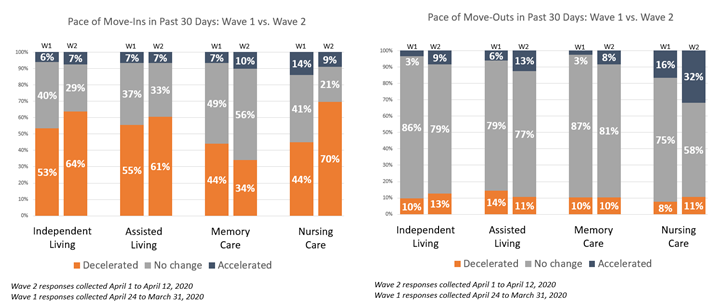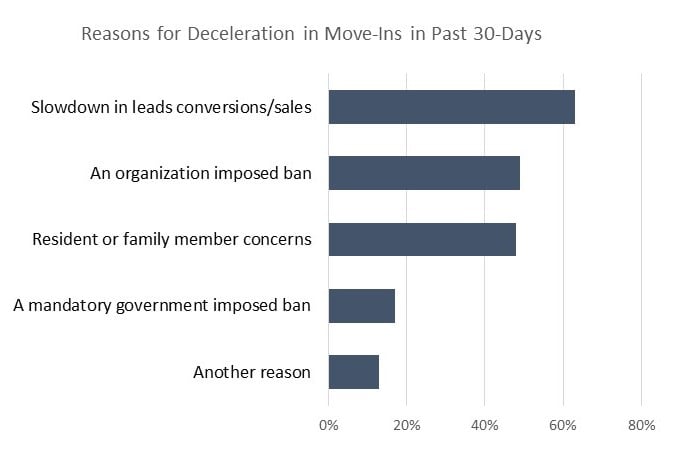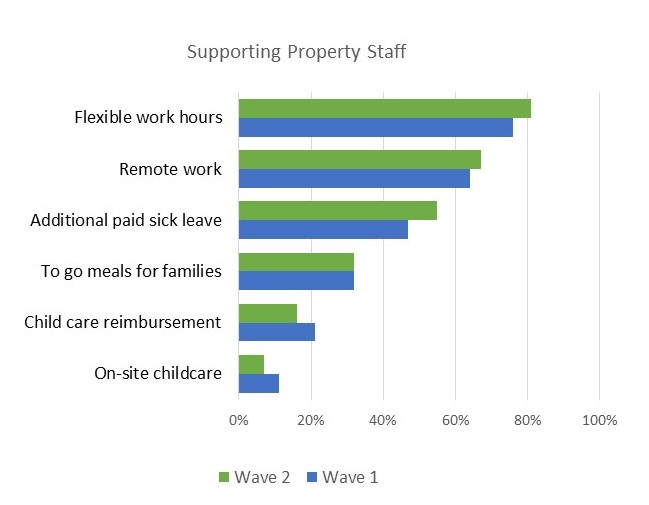In response to the COVID-19 pandemic and associated economic crisis, NIC has launched a number of initiatives designed to inform the seniors housing and care industry, even at today’s rapid pace of change. One of these is our “Executive Insights Survey,” which takes the pulse of hundreds of operators, representing thousands of properties across the country. Survey results and analysis are now published weekly, on this NIC Notes blog. Respondents are senior executives, tasked with leading their organizations through this existentially threatening crisis, both in terms of the health of their residents, and the viability of their businesses. Surveys are distributed weekly to assess occupancy rates, move-in and move-out rates, the development pipeline, staffing, and supports for front-line community employees and staff.
NIC has now released the second week’s “wave” of results from the survey, along with expert analysis from NIC Senior Principal, Lana Peck. While many industry stakeholders, including operators, equity and debt providers, institutional lenders, and a host of service providers, are looking at this weekly pulse check as an indicator of the pandemic’s impact on the industry’s ability to maintain occupancy rates and other key metrics, the survey is also providing insight in more human terms. As reflected in many of the comments in the most recent “NIC Leadership Huddle” webinar (another unique NIC initiative), capital providers and operator executives are fighting a tough battle, often with little support from the government, to keep COVID-19 away from their residents. Survey respondents can leave their comments and concerns, many of which reflect the impact of the crisis on a more human level.
“We feel we are alone in a war zone.”
“We do our best; under the current scenario, the worst isn’t here yet.”
Many comments reflect the reality that in most states and localities, seniors housing and care is not being prioritized for the supplies and support that it needs, despite the fact that these communities are caring for millions of high-risk frail elders. Senior executives and hourly workers alike are working long hours, struggling day and night to meet the often complex needs of their residents while simultaneously protecting them from a disease which is highly contagious, impossible to see, and can be carried for weeks by asymptomatic workers. They know that once COVID-19 gets “in,” it will be deadly, particularly for residents with the pre-existing conditions that are commonplace within these communities.
“Tough times…doing everything we can to keep our residents and staff safe.”
“Post-acute providers are getting no supplies and no financial assistance in COVID response planning. We shelter and care for the most vulnerable to the disease and yet there seems to be no incentive to help us shelter them in place while hospital beds are consumed by the 20% most affected.”
One of the key concerns reflected in survey comments is a lack of available, accurate, and timely testing. This was discussed by the panelists in the most recent “leadership huddle,” who agreed that testing is an essential component of protecting these residents – and is in dangerously short supply, is not always reliable, and sometimes takes too long to be effective.
“Lack of testing is a major concern. We have positive cases but can’t get all residents tested unless they have symptoms. By that point, it’s almost too late to do anything.”
“Given that our employees could be infected, yet be asymptomatic, it is hard to ever feel comfortable that you are doing enough.”
Another key challenge facing these leaders is the scarcity, and now the high cost, of personal protective equipment (PPE). Many report that they are straining to find sufficient PPE, which is complicating efforts to support exhausted staff, many of whom are fearful for the safety of their own families.
“One of the largest concerns we have now is when will COVID-19 peak and getting the necessary PPE to protect staff and other residents.”
“…there are few if any personal protective equipment (PPE – gloves, gowns, etc.) distributions targeted to senior care.”
“Not surprisingly, call outs have increased and availability of PPE has decreased.”
Survey respondents worry about the effect that the pandemic is having on already strained labor force issues. Many front line workers are parents who have children at home. How are they to work long shifts demanded by the additional effort to protect residents – and prepare meals, home school children, and protect their own families?
“Front line staff considering quitting and taking unemployment verse caring with no PPE and kids at home without oversight”
“Staffing becomes critical once a positive COVID resident is identified.”
“Biggest worry is labor shortages; increasing number of staff either testing positive or presumptive position and calling out because of fear. Have an all-out hiring push on, but it takes time and could be difficult because of fear of virus.”
The comments reveal a perspective that is seldom represented in media reports: that it is no easy task to fight this highly contagious killer, particularly in a senior living environment populated with frail elders who often require hands-on assistance, specialized care services, and close monitoring every day and night. Many operators are fighting to save lives, while simultaneously easing the anxieties and concerns of their residents, staff, and families.
“We have been fortunate that our staff have been able to continue their regular hours of work. Closing down our Health Center and not allowing family or friends to visit has been difficult for residents to understand. Independent living residents don’t like the social distancing. As CEO, I send out updates to residents, families, staff to make sure they are informed and know what we are doing to keep everyone safe.”
Some comments include concerns about the media and public attitudes toward the industry. Headlines on infections and deaths, sometimes characterized as occurring in “nursing homes” are on the front pages of every newspaper and are discussed in prime time on live TV. While many journalists and commenters are rightly lionizing the heroic efforts of the healthcare workers in hospitals, too often they tend to take a different tone when discussing the crisis threatening frail elders in seniors housing and care settings. The operators are noticing this, and it is highly likely that their staff is, too. A recent Op-ed in The Hill, written by Bob Kramer and Jacqueline Kung, highlights the importance of this type of press coverage – and the damage it may be doing to the sector’s ability to function.
“There is lots of confusion in the media and news about all seniors housing being the same – IL, AL and MC are not like nursing or skilled care. As an industry, there needs to be better messaging around how each product and service is different in relationship to COVID-19.”
Across this survey, and other NIC initiatives, it is becoming clear that what is most needed, in order to save lives now, is PPE, access to testing, and support from local, state, and Federal government leaders. As Kramer and Kung point out in their Op-ed, what is not needed is the public perception that the care workers fighting to keep seniors – and the rest of us — healthy on the front lines of this pandemic are any less heroic and worthy of support than their counterparts working in the hospitals across town. Rather than pointing fingers, it would be helpful to recognize that they are humans, too.








